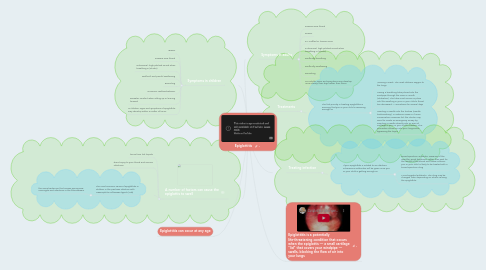
1. A number of factors can cause the epiglottis to swell
1.1. burns from hot liquids
1.2. direct injury to your throat and various infections
1.3. The most common cause of epiglottitis in children in the past was infection with Haemophilus influenzae type b (Hib)
1.3.1. the same bacterium that causes pneumonia, meningitis and infections in the bloodstream
2. Epiglottitis can occur at any age
3. Symptoms in children
3.1. •Fever
3.2. •Severe sore throat
3.3. •Abnormal, high-pitched sound when breathing in (stridor)
3.4. •Difficult and painful swallowing
3.5. •Drooling
3.6. •Anxious, restless behavior
3.7. •Greater comfort when sitting up or leaning forward
3.8. In children, signs and symptoms of epiglottitis may develop within a matter of hours
4. Epiglottitis is a potentially life-threatening condition that occurs when the epiglottis — a small cartilage "lid" that covers your windpipe — swells, blocking the flow of air into your lungs
5. Symptoms in adults
5.1. •Severe sore throat
5.2. •Fever
5.3. •A muffled or hoarse voice
5.4. •Abnormal, high-pitched sound when breathing in (stridor)
5.5. •Difficulty breathing
5.6. •Difficulty swallowing
5.7. •Drooling
5.8. For adults, signs and symptoms may develop more slowly, over days rather than hours
6. Treatments
6.1. The first priority in treating epiglottitis is ensuring that you or your child is receiving enough air
6.1.1. Wearing a mask. The mask delivers oxygen to the lungs
6.1.2. Having a breathing tube placed into the windpipe through the nose or mouth (intubation). The tube must remain in place until the swelling in your or your child's throat has decreased — sometimes for several days
6.1.3. Inserting a needle into the trachea (needle tracheostomy). In extreme cases or if more conservative measures fail, the doctor may need to create an emergency airway by inserting a needle directly into an area of cartilage in your or your child's trachea. This procedure allows air into your lungs while bypassing the larynx
7. Treating infection
7.1. If your epiglottitis is related to an infection, intravenous antibiotics will be given once you or your child is getting enough air
7.1.1. Broad-spectrum antibiotic. Because of the need for quick treatment, rather than wait for the results of the blood and tissue cultures, you or your child is likely to be treated with a broad-spectrum drug
7.1.2. More-targeted antibiotic. The drug may be changed later, depending on what's causing the epiglottitis
